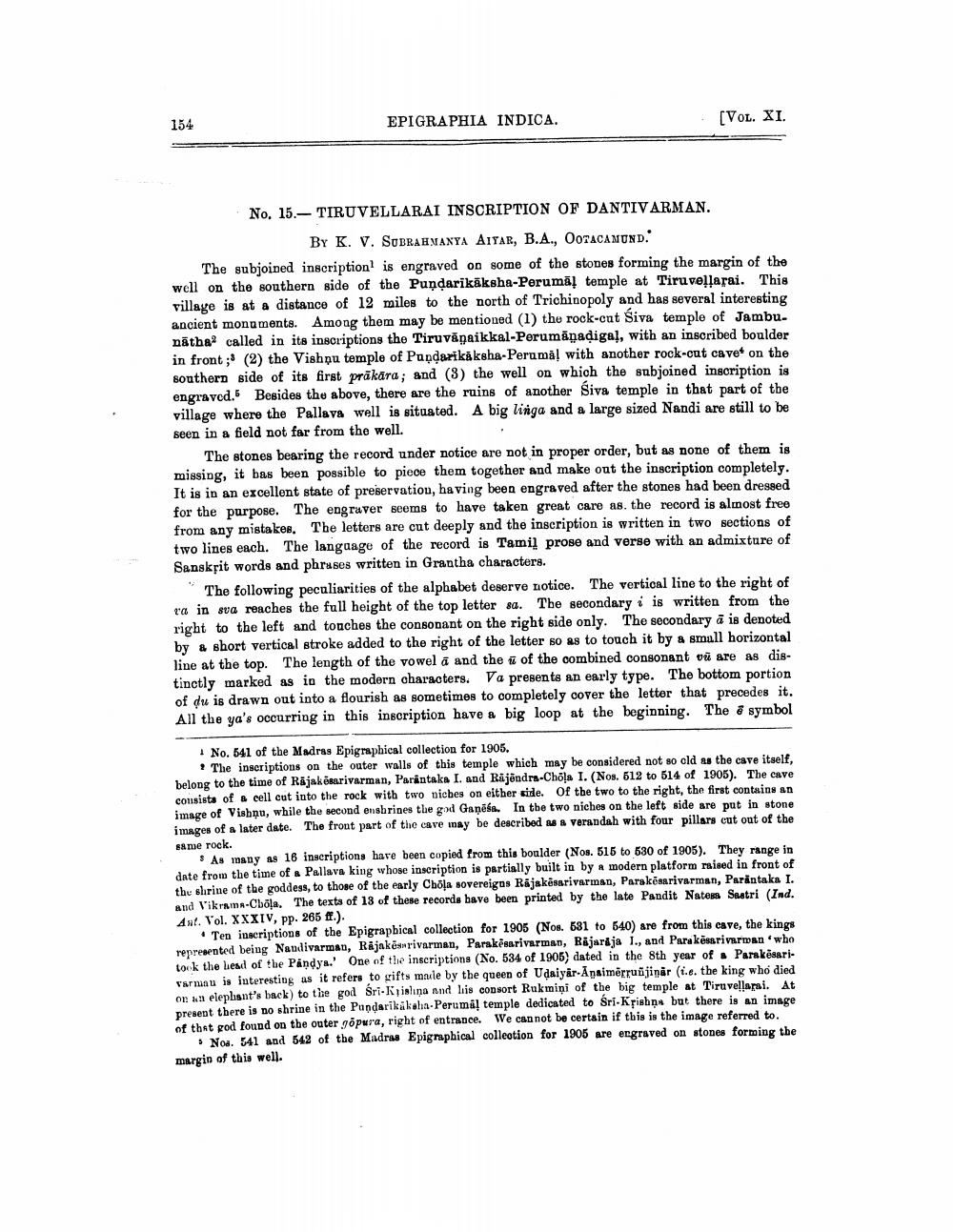________________
154
EPIGRAPHIA INDICA,
[VOL. XI.
No. 15.- TIRUVELLARAI INSCRIPTION OF DANTIVARMAN.
By K. V. SUBRAHNANYA AITAR, B.A., OOTACAMUND: The subjoined inscription is engraved on some of the stones forming the margin of the well on the southern side of the Puņdarikāksha-Perumal temple at Tiruvellarai. This village is at a distance of 12 miles to the north of Trichinopoly and has several interesting ancient monuments. Among them may be mentioned (1) the rock-cut Siva temple of Jambu. nāthal called in its inscriptions the Tiruviņaikkal-Perumāņadiga!, with an inscribed boulder in front ;(2) the Vishnu temple of Pandarikāksha-Peruma! with another rock-cut cave on the southern side of its first prākara; and (3) the well on which the subjoined inscription is engravod. Besides the above, there are the ruins of another Siva temple in that part of the village where the Pallava well is situated. A big linga and a large sized Nandi are still to be seen in a field not far from the well.
The stones bearing the record under notice are not in proper order, but as none of them is missing, it bas been possible to piece them together and make out the inscription completely. It is in an excellent state of preservation, having been engraved after the stones had been dressed for the purpose. The engraver seems to have taken great care as the record is almost free from any mistakes. The letters are cut deeply and the inscription is written in two sections of two lines each. The language of the record is Tamil prose and verse with an admixture of Sanskrit words and phrases written in Grantha characters.
"The following peculiarities of the alphabet deserve notice. The vertical line to the right of ra in sva reaches the full height of the top letter sa. The secondary i is written from the right to the left and touches the consonant on the right side only. The secondary ā is denoted by & short vertical stroke added to the right of the letter so as to touch it by a small horizontal line at the top. The length of the vowel a and the of the combined consonant vu are as distinctly marked as in the modern characters. Va presents an early type. The bottom portion of du is drawn out into a flourish as sometimes to completely cover the letter that precedes it. All the ya's occurring in this inscription have a big loop at the beginning. The é symbol
No. 541 of the Madras Epigraphical collection for 1905.
+ The inscriptions on the outer walls of this temple which may be considered not so cld as the cave itself, belong to the time of Rājakēnarivarman, Parantaka I. and Rajöndrs-Chola I. (Nos. 512 to 514 of 1905). The cave consists of a cell cut into the rock with two vicbes on either side. Of the two to the right, the first contains an image of Vishnu, while the second enshrines the god Gaņēs. In the two niches on the left side are put in stone images of a later date. The front part of the cave may be described as verandah with four pillars cut out of the same rock.
As many as 16 inscriptions have been copied from this boulder (Nos. 516 to 630 of 1905). They range in date from the time of a Pallava king whose inscription is partially built in by modern platform raised in front of the shrine of the goddess, to those of the early Chola sovereigos Rájakesarivarman, Parakesarivarman, Parintaka I. and Vikrama-Cböla. The texts of 13 of these records bave been printed by the late Pandit Natess Sastri (Ind. Asil. Vol. XXXIV, pp. 265 f.).
• Ten inscriptions of the Epigraphical collection for 1905 (Nos. 681 to 640) are from this cave, the kings represented being Nandivarman, Rajakesarivarman, Parakesarivarman, Rijardja 1., and Parakossrivarman who took the lead of the Pandya.' One of the inscriptions (No. 534 of 1906) dated in the 8th year of Parakesarivarmou is interesting as it refers to gifts male by the queen of Udaiyar-Apaimērruijinar (e. the king who died on an elephant's back) to the god Sri Krislina and liis consort Rukmini of the big temple at Tiruvellarai. At present tbere is no shrine in the Pandarikáksha-Perumal temple dedicated to Sri Krishna but there is an image of that god found on the outer gopura, right of entrance. We cannot be certain if this is the image referred to.
Noa. 541 and 542 of the Madras Epigraphical colleotion for 1905 are engraved on stones forming the margin of this well.




